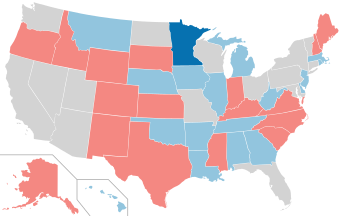| ← 1988 1989 1990 1991 1992 → Midterm elections | |
| Election day | November 6 |
|---|---|
| Incumbent president | George H. W. Bush (Republican) |
| Next Congress | 102nd |
| Senate elections | |
| Overall control | Democratic hold |
| Seats contested | 35 of 100 seats (33 seats of Class 2 + 2 special elections) |
| Net seat change | Democratic +1 |
 | |
| 1990 Senate election results Democratic gain Democratic hold Republican hold | |
| House elections | |
| Overall control | Democratic hold |
| Seats contested | All 435 voting seats |
| Popular vote margin | Democratic +7.8% |
| Net seat change | Democratic +7 |
 | |
| 1990 House of Representatives election results Democratic gain Democratic hold Republican gain Republican hold Independent gain | |
| Gubernatorial elections | |
| Seats contested | 38 (36 states, 2 territories) |
| Net seat change | Alaskan Independence +1, A Connecticut Party +1 |
 | |
| 1990 gubernatorial election results Democratic gain Democratic hold Republican gain Republican hold Alaskan Independence gain A Connecticut Party gain | |
Elections were held on November 6, 1990 and elected the members of the 102nd United States Congress. The elections occurred in the middle of Republican President George H. W. Bush's term and during the Gulf War. The Democratic Party slightly built on their control of Congress.
Contents
The Democratic Party built on its majorities in both chambers of Congress. They picked up a net of one seat in the Senate. [1] Democrats won the nationwide popular vote for the House of Representatives by a margin of 7.8 percentage points, picking up a net of seven seats. In the gubernatorial elections, both parties lost a net of one seat to third parties.